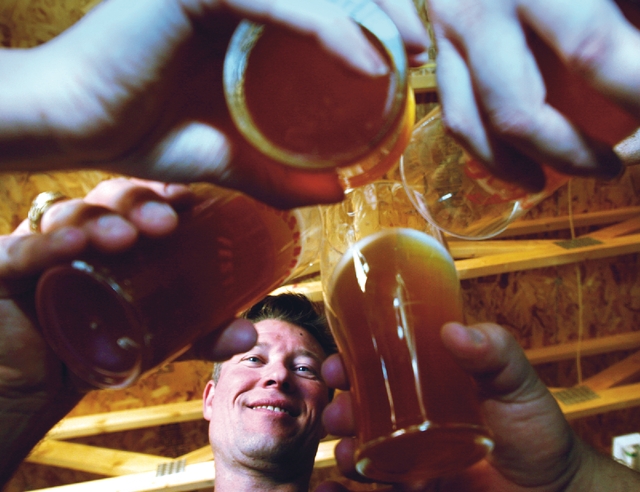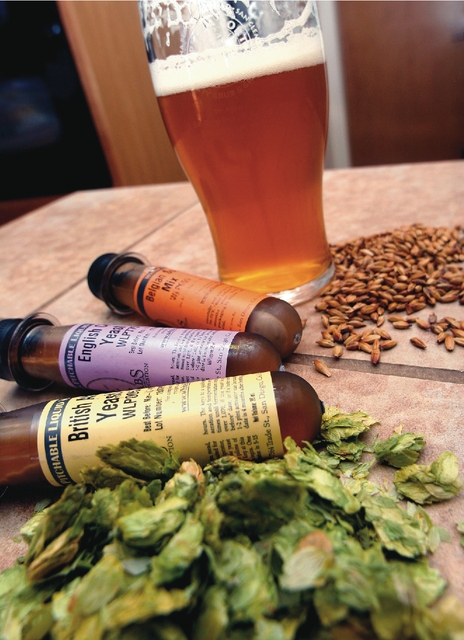The secondary mission of Dukes of Ale: Teach people how to taste beer. President Todd Coffey has visited brew pubs around the country. "I try all their beer, and they’re usually infected or there’s something wrong with them—and they taste bad. But they’re usually popular. People just keep going in there and buying this beer." Albuquerque’s homebrewers club seeks to stop this ill-informed beer-loving. "We want to help people understand and taste what is really high-quality beer. And how do you describe it? And why is it better than some of the other stuff that you taste?"The primary mission, though, is to share knowledge about beermaking. Some Dukes meetings look like a casual party, a group of about 30 people drinking beer. A large, polished steel vat at Marble Brewery looms over a table undecorated except for homebrews of all shapes and sizes: bottles marked with colorful home-printed labels, a clear glass jug housing a beer as dark as espresso, a pitcher of beer tagged with masking tape. As always, there’s one or two commercial brews on the table. Everyone’s got a glass. The schedule is rolled out at the beginning of the year, with each monthly meeting given over to a type of beer: IPAs, pilsners, Oktoberfests or sour ales, for example. Club members brew up a batch and compare it to commercial versions. Dukes of Ale often hosts technical meetings on topics like yeast propagation, how to grow hops or what kind of equipment you need to set up beer on draft. Guy Ruth is one of a handful people who founded Dukes of Ale in 1989. "There were only four or five other people interested," he says. A zymurgist since 1972, he’s not as active in the club these days, though he’s still brewing with his abundant 40-gallon home system. His most recent brew was a porter, though he’s particularly fond of stouts and IPAs. Coffey began brewing years ago using extract, as most new brewers do. Extract can come in powder or syrup form. Add water to it, and you’ve got instant wort, the grain liquid that ferments to become beer. As he grew more advanced, he got into "all-grain"—it’s a process where you steep grain in water, cook it in an oven, steep it again at a specific pH value and drain all the liquid off to create wort. Whether you make your wort from scratch or just buy the extract, you proceed to boil it, add hops to it and stir in specialty grains to increase the flavor profile. No matter how far into brewing Coffey’s gone, he says he always learns something at one of the club’s brewing days, where he invites members over to his house to help him brew.Brian Ausderau, a three-time president of Dukes of Ale, has lately been adding raspberries, cherries or mango to wheat beers and light lagers. The results aren’t sweet, because the fruit sugar ferments out completely. "You’re left with nothing but the fruit essence and some acid, actually," he says. "It can sour." His setup is basic and includes a converted beer keg, a picnic cooler and a kettle. "It doesn’t require exotic equipment," he says. Victor Trujillo, owner of the only homebrew supply store in Albuquerque, says if you can boil water, you can brew beer. "It’s not rocket science. Just be sure of your cleanliness and follow the directions." Victor’s Grape Arbor has been around for 33 years and sells starter kits for $79. Ausderau started thinking about homebrewing in college, "because everybody does. Beer is good, and it costs too much money." Money isn’t as much of an issue anymore, so he doesn’t bother with cloning, which is using recipes to replicate commercial beers like Guinness or Heineken. His primary motivation for brewing is discovery—to sample beers you can’t get anywhere else. Beer culture has come a long way in the last 15 years, Ausderau says. "When I started out, if you wanted to taste a genuine Munich dunkel, you really couldn’t find a fresh one on the shelf anywhere," he says. "Nobody was making a local version, so you had to make it yourself if you wanted to experience that." Ausderau has been a member of Dukes of Ale since the mid ’90s and watched the membership swell and recede in lockstep with the microbrewing revolution. "It peaked out in the late ’90s, and then you saw a lot of brewpubs going out of business," he says. "The ones that settled out were the ones that knew how to do it right. They were making consistently good beer all the time." Still, some of the best beers come from homebrewers, says Coffey, for simple economic reasons. "In a homebrew setting, I can put 15 different grains and 15 different hops in a particular beer, because I can buy them all in small quantities, and it’s not a big deal," he says. Larger breweries scale back on ingredients because they can’t afford to buy that many specialty grains for what might be used only once or twice a year. They can’t tolerate as much risk, and therefore don’t have opportunities to experiment, Coffey says. "The bigger they get, the more challenging it is for them to make really exceptional beers that are very different from each other."Dukes of Ale welcomes all beginning zymurgists, and Ausderau says the club is a great way to ramp up your brewing skills fast. Ausderau’s advice to new brewers? "Start simple. It’s the kind of hobby where you make a good batch right off the blocks, given a few pieces of equipment and a basic set of ingredients."
Dukes of Ale meetings are typically held at 7 p.m. on the first Tuesdays of every month at Marble Brewery (111 Marble NW). Membership costs $25 per year and comes with an official tasting glass, a notebook that includes beer style guidelines, the yearly calendar and recipes. Brewers of all skill levels are welcome. For more, go to www.dukesofale.com.











